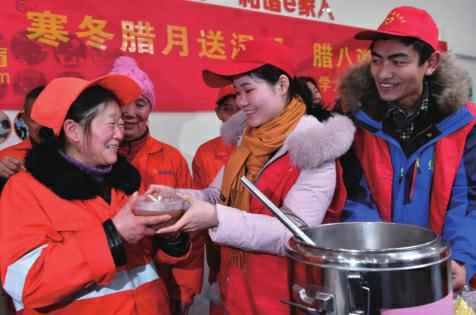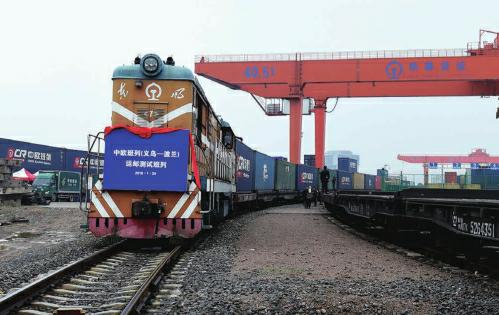Harvest Dance
Villagers dance to celebrate the New Year in Chusong Village in Xigaze, southwest Chinas Tibet Autonomous Region, on January 17. In Xigaze and other farming regions in Tibet, people celebrate the New Year on the fi rst day of the 12th month of the Tibetan lunar calendar. According to local farming tradition, the spring ploughing season always begins on the New Year, thus celebrating one month earlier meets the needs of local agriculture.
Hydrogen City
Wuhan, capital of central Chinas Hubei Province, will build itself into a hydrogen city through developing its hydrogen energy industry, according to a recently released city development plan.
The city is to advance the research and development of core technology for hydrogen production, storage and transportation, improving hydrogen infrastructure over the coming years.
A hydrogen energy industrial park is expected to be built in the city, gathering more than 100 fuel cell automakers and related enterprises, the plan said.
The city will build up to 20 hydrogen fueling stations from 2018 to 2020 to support the running of around 3,000 hydrogen powered vehicles.
Wuhan is scheduled to become a world hydrogen city by 2025, with three to fi ve trailblazing hydrogen enterprises and 30 to 100 hydrogen fueling stations. The annual production value of hydrogen fuel cells for vehicles will exceed 100 billion yuan($15.63 billion), the plan added.
“Despite a late start, China has made rapid progress in hydrogen development, mastering the core technologies of the hydrogen fuel cell,” said Zhang Qingjie, President of Wuhan University of Technology.
TCM Innovation
According to a statement from the State Administration of Traditional Chinese Medicine, China will continue to push forward technological innovation in traditional Chinese medicine (TCM), with plans to build more TCM labs and research centers in the near future.
The administration highlighted the development of the TCM industry during the past fi ve years and also promised the further promotion of TCM.
Wang Guoqiang, head of the administration, said that in addition to the Nobel Prize in Physiology or Medicine won by pharmaceutical chemist Tu Youyou in 2015, 41 new TCM discoveries have won state science and technology awards since late 2012.
Over 400 ancient books on TCM have been edited and published during the past fi ve years, Wang added.endprint
According to recent fi gures provided by the administration, about 17.5 percent of all patients in China are treated with TCM.
As of September 2017, 20.4 million patients had been discharged from TCM hospitals, accounting for 15 percent of all discharged patients in the country, the administration said.
Currently, 67 percent of townlevel and community health centers have TCM units, totaling more than 30,000 nationwide. By September 2017, there were 45,800 TCM clinics across China.
Safe Travel Rush
Chinas Ministry of Public Security has asked police departments across the country to guarantee the safety and fl ow of traffi c during the upcoming travel rush for the Spring Festival.
Police should investigate and rectify potential safety risks before the 40-day rush starts on February 1, according to a notice issued by the ministrys traffi c management bureau.
It also asked police to optimize the handling of traffi c congestion, as around 2.98 billion trips are expected to be made during this years holiday period.
Police should also step up emergency management and spare no effort in dealing with bad weather conditions such as low temperatures, snow and ice, the notice said.
It also stressed that traffi c police and volunteers should be organized to provide services.
Infrastructure Upgrading
According to a notice jointly issued by several ministerial level departments, China plans to improve cultural, medical and scientifi c and technological infrastructure and services in rural areas, particularly those with high levels of poverty.
Free movie screenings and library services will be continued in remote villages and more scientif ci and technological infrastructure and services will be built, said the notice, which was jointly issued by the Publicity Department of the Communist Party of China (CPC) Central Committee and other relevant departments.
Specialized medical teams will be dispatched to treat patients in former revolutionary bases, ethnic minority regions, border zones and impoverished areas, the notice added.
The CPC and relevant government departments should carry out events in poorer regions and provide favorable policies in these areas in terms of funding and services, it said.
The notice also called for contributions from individuals and private businesses.
Produce Quality
According to the Ministry of Agriculture, China will expand the range of its quality controls in order to improve food safety.endprint
The ministry will add 28 monitoring indices, including some pesticides and veterinary antibiotics, to the current 94-item produce quality monitoring list.
Monitoring efforts will be targeted at vegetables, fruit, tea, livestock, poultry and seafood. The produce quality monitoring mechanism started in Beijing, Tianjin, Shanghai and Shenzhen in 2001, and now covers over 150 cities in 31 provincial regions.
The overall pass rate for sample testing stood at 97.8 percent in 2017, up 0.3 percentage points year on year.
The agriculture ministry has called 2018 “the year of agricultural quality,” outlining major tasks, including promoting green production, wider quality monitoring and brand promotion.
Power Use
Chinas electricity consumption, a key barometer of economic activity, rose 6.6 percent to 6.31 trillion kilowatt hours in 2017, offi cial data showed on January 22.
The rate was faster than the 5-percent increase for 2016, according to data released by the National Energy Administration (NEA).
Electricity used by the service sector rose 10.7 percent last year, followed by a 7.3-percent increase for the agricultural sector and 5.5 percent for the industrial sector. Residential power use rose 7.8 percent, the NEA said.
Last year, China added 133.72 gigawatts of new power generation capacity, with 34.2 percent thermal power and 9.6 percent hydropower.
The rapid growth in power consumption came amid faster economic growth. Chinas economy expanded 6.9 percent last year, picking up for the fi rst time in seven years and well above the government annual target of around 6.5 percent.
Data from the National Development and Reform Commission showed that total power generation in 2017 rose 6.5 percent, with power from clean energy sources up 10 percent, outpacing the 5.2-percent growth for thermal power.
Electricity from nuclear, wind and solar power plants rose 16.5 percent, 26.3 percent and 75.4 percent, respectively.
Tourism Growth
Northwest Chinas Xinjiang Uygur Autonomous Region welcomed a record high of 107 million tourists in 2017, up 32.4 percent year on year.
The number was announced by Shohrat Zakir, Chairman of the Xinjiang regional government, when he delivered a government work report at the ongoing session of the regional peoples congress.
In addition, tourists spent over 182 billion yuan ($28.4 billion) in Xinjiang last year, 30 percent more than in 2016.endprint
As tourism is seen as a barometer of stability and harmony, Zakir said, Xinjiangs tourism performance“shows again that Xinjiang is a great place.”
During the past year, improved social stability has provided conditions and guarantees for Xinjiangs economic and social development, giving residents a better sense of security, he said.
Calling tourism “an important pillar of industry with the greatest potential” in Xinjiang, the report said that the region should strive for at least a 30-percent year-on-year growth in tourist numbers for 2018.
Getting Connected
Passengers use the infl ight WiFi on board Hainan Airlines fl ight HU7781 on January 18. On that day, China Eastern Airlines and Hainan Airlines began allowing passengers to use portable electronic devices such as smartphones and tablets although devices must still be switched to the airplane mode while in the air. Several other Chinese airlines are considering similar moves.
Warmth in Winter
Volunteers offer Laba porridge to sanitation workers in Hefeis Yaohai District, east Chinas Anhui Province, on January 22. The Laba Festival, a traditional Chinese celebration on the eighth day of the 12th lunar month, fell on January 24 this year. It is customary on this day to eat a special porridge made with at least eight ingredients, representing peoples prayers for harvest.
Removing Barriers
China will target institutional barriers and deeply embedded interests in reform this year, said a statement from a Communist Party of China(CPC) reform leading group on January 23.
Priority should be given to reforms in key areas including state-owned enterprises and state-owned assets, monopoly sectors, finance and taxation, property rights protection, rural revitalization, social security, opening up, and ecological conservation, according to the statement, issued after the second meeting of the Leading Group for Deepening Overall Reform of the 19th CPC Central Committee.
President Xi Jinping, also General Secretary of the CPC Central Committee and head of the group, presided over the meeting and delivered a speech.
Xi highlighted the importance of reform in 2018 and called for new breakthroughs with strengthened innovation and concrete efforts.
Reform should be more systematic, holistic and coordinated to seek substantive progress in fundamental areas, the statement said.endprint
Leading offi cials should lead by example in reform, and more efforts are required in research and supervision of reforms, according to the document.
At the meeting, a plan for the groups work this year and guidelines for a series of reform measures were approved.
Access All Areas
The Chongqing-Guiyang high-speed railway, a crucial line in southwest China, is put into use on January 25, with a designed speed of 200 km per hour.
Asia Forum
The Boao Forum for Asia (BFA) Annual Conference 2018 will be held from April 8 to 11 in Boao, south Chinas Hainan Province, under the theme of “an open and innovative Asia for a world of greater prosperity,” said BFA Secretary General Zhou Wenzhong on January 25.
Increased anti-globalization and protectionist rhetoric and actions have caused setbacks in efforts to advance globalization, Zhou said at a press conference in Beijing.
In this context, the Asia-Pacifi c region needs development that is more open, better coordinated, more inclusive and more balanced than ever before, he added.
The BFA is a nongovernmental and nonprofi t international organization with a purpose of promoting economic exchanges and cooperation within Asia and between Asia and other parts of the world. Since 2002, BFA has been holding its annual conference in the beach resort town of Boao.
This years annual conference is scheduled to be divided into four modules—Globalization and the Belt and Road Initiative, an Open Asia, Innovation, and Reform.
Communication Satellite
Shijian-13, Chinas fi rst high-throughput communication satellite, has been put into service after completing a key laser communication test, China National Space Administration said on January 23.
The high-orbit satellite has completed a two-way, high-speed laser communication test between the satellite and the ground, the fi rst of its kind in the world, the administration said in a statement.
Serving users in China, the satellite will connect communication base stations in remote areas and meet the needs of distance education, digital news gathering, and emergency communication, said Li Feng, chief satellite designer at China Aerospace Science and Technology Corp.
The satellite, renamed Zhongxing-16 after it was put into service, will provide better Internet access on planes and high-speed trains, according to the statement.endprint
High-throughput communication satellites can form a communication network with larger transfer capacity and higher transfer speeds compared with ordinary satellites.
A communication network covering China and the Asia-Pacifi c region is expected to be established in 2020, as China sends more highthroughput communication satellites into space, said the statement.
Online Mediation Platform
China launched an online platform on January 24 to mediate copyright disputes to free all parties involved and mediators from traveling.
Applicants can choose mediators from other cities, since all steps, including application, testifying, cross-examination and mediation, are to be done online.
The platform not only saves costs, but shares resources across the country, said an off ciial from the Copyright Protection Center of China, a co-host of the platform.
From 2013 to 2016, the number of copyright registrations in China doubled from over 1 million to more than 2 million, said a report compiled in 2017 by the Standing Committee of the National Peoples Congress.
Since 2010, Chinese police have handled almost 10,000 criminal cases of copyright violation, detaining over 11,000 suspects.
Aviation Database
Chinas top aviation regulator partnered with U.S. companies to develop the countrys aviation navigation database on January 24.
The Air Traffi c Management Bureau with the Civil Aviation Administration of China inked a cooperation agreement with U.S. aviation solutions provider Jeppesen and industrial giant Honeywell to make a sound database for aviation navigation.
China is home to 235 civil airports, but only 66 of them can have their data entered into the aviation navigation database, posing risks to fl ight safety, according to Che Jinjun, head of the Air Traffi c Management Bureau.
Navigation is more demanding for aircraft than for other forms of transport in terms of data precision and timeliness.
China has been addressing its incomplete aviation navigation database for several years, and the partnership will help offer new solutions, according to Che.
Joy Ride
Students ride shared bikes on a school campus in New Delhi on January 23. Chinese company Ofo has launched pilot projects in seven Indian cities, with 3,000 of its bikes to appear in the country by the end of January.
Telecom Market
China is considering further opening its telecom market by granting private virtual telecom operators formal commercial licenses, the Ministry of Industry and Information Technology (MIIT) announced on January 24.endprint
The draft decision came after over four years of pilot schemes in 29 provincial regions by 42 private fi rms.
Starting in 2013, qualifi ed virtual telecom operators could resell mobile communication services under their own brand through leasing telecom operators networks and facilities or other forms of cooperation.
The pilot schemes have served more than 60 million users and attracted private investment worth 3.2 billion yuan ($50 million).
The formal commercial licenses are open to all qualifi ed market players, including foreign-invested fi rms, according to Chen Jiachun, a senior offi cial with the MIIT.
The MIIT will enhance market regulation to ensure information security and protect users rights, Chen added.
More Housing Supply
Beijing plans to allocate 1,200 hectares of land for the building of residential houses this year, and more will be added to further develop the citys house rental market.
The remarks were made by acting Mayor Chen Jining while he delivered the municipal governments work report at the opening of the annual session of the Beijing Municipal Peoples Congress on January 24.
In 2018, Beijing will promote the construction of 2.9 million square meters of joint ownership housing and 6 million square meters of commercial housing, for which the construction land has already been allocated.
Chen said the city would develop the rental housing market, especially the market for longterm renting, and further promote construction of rental housing on collectively owned rural land.
The city has seen no monthon-month growth in the prices of new commercial housing for 15 consecutive months, and the price index for second-hand homes has been dropping for eight consecutive months.
The city has introduced a spate of measures including higher down payments, higher mortgage rates and tougher purchase restrictions as well as joint property rights to cool its housing market.
Beijing supplied a total of 721 hectares of construction land for residential housing last year. In April 2017, the city announced plans to supply 6,000 hectares of land by 2021 in a bid to meet the market demand for residential housing.
Express Delivery
A cargo train loaded with mail sets off from Yiwu, east Chinas Zhejiang Province, on January 24, bound for Mataszewicze in Poland. The test run will make Yiwu the second city in China to offer a postal train service from China to Europe. endprint
endprint

